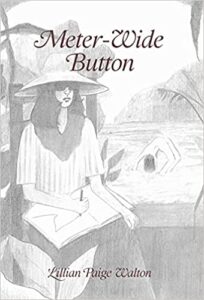
[Sapp Press; 2021]
A woman in a writing retreat loses her grasp on reality. A dentist weeps at the discovery of an odd-colored tooth. A woman taking a bath pummels through her wall after an unexpected interruption. In Meter-Wide Button, Lillian Paige Walton’s debut short story collection, people unravel. After a series of odd turns, breaking points are reached. But what materializes across these stories isn’t just a narrative of defeats. In a balancing act, Walton prods her stories until they blush with poignancy. The odd turns of each story serve the larger purpose of examining the present. Walton understands the assignment; she knows that a story cannot be odd just for the sake of oddness. As a result, she serves us both moments of compassion and social critique across each tale.
The fictions in Walton’s collection are brilliantly surreal; Walton favors the bizarre, sometimes the macabre, and always the dry. The stories in Meter-Wide Button are funny. They vary in length, some hardly more than two pages — these were easily some of the standouts, the stories in which little is given in way of backstory and where Walton deliciously leans into the odd. In “Excavation,” for example, a dentist works on a patient, while archeologists work on a site outside his window. There are parallels, of course. The way in which the dentist digs through his patients’ mouth in search of something is not unlike the digging and searching of the archeologists. It is in the chilling details that Walton shines: “He tapped her bottom lip to encourage her to open her mouth, not realizing he was opening his own behind his mask in the process.” And in the unexpected: “He stared at the tray where the probe lay — strange tooth still attached — and began to weep. In the lot below, a voice cried out in French. Something had been found.” It is a simple comparison to juxtapose the two scenarios, but eerie all the same. The story is a good primer for the collection; it warms us up as we step into its world, learning its odd realities. Here, Walton lays the groundwork for us, though nothing that follows is what it seems.
Many of Walton’s stories are writerly ones that center the creative process. Two feature residencies of some sort, one self-imposed and the other on another planet altogether. Another, aptly titled “The Room In Which I Write,” is all about the room in which a character writes. In painstaking but surprisingly humorous detail, Walton carves out the specifics that define the space: “The room in which I write has no door, so it must be entered from below. I enter with my head first, removing the small window of film that separates the room in which I write from the room in which I do not write.” But Walton goes where you least expect. “On good nights I am left alone. On bad nights snakes pass over my ankles,” she writes. “Sometimes the floor is covered in water, but more often it is filled with sand.” Then, Walton ends the story by describing the exit: “My exit is similar to how I enter; feet first, instead of head.”
In “Residency,” a budding writer prematurely quits her day job to pursue a career as a writer. She begins a “self-imposed residency” at her home. Over the course of the story, we watch as Louise slowly unspools when things do not go her way: her AC breaks down, the sex moans from her neighbors next door ping through the wall, the doorknob from her door falls off. And, of course, there’s the writing itself: “Reading the words conjured no mental image of their meaning, a dilemma which reminded her of trying to read a menu when she had gone too long without eating,” writes Walton. Most surprising, however, is what Louise’s actual manuscript holds: “As a young man, he’d always thought that he was only into big boobs, but as he grew older, he realized he was also kind of into small and medium-sized boobs, too.” This was a laugh-out-loud moment, however discomfiting, in a collection where there are many. But there’s a certain poignancy in this story, as in the rest of the collection. “As the sun dipped into the horizon, something left Louise. It came from a place below her ribs and caused the bird to flit suddenly from the ledge of the window,” writes Walton. It would be easy for Walton to settle into the kind of detached and cold prose that is common in contemporary literature. But Walton is more interested in the psychological mechanics behind her characters: they are people after all. What got them this way, this far? Characters ought to be imbued with humanity, especially if you go on to critique them. Otherwise, wouldn’t this writing just be satire?
In the titular story, an artist-in-residence on an alien planet navigates its contrived but technologically-advanced healthcare systems while also engaging in his own survival tale. It is in stories like this where the collection surprised me most, reminding me that it is in fact one of this moment. Mostly, I mean Walton consciously includes details that identify the collection to the present, or even the near future. Texts, technology in general, and social conundrums of today occupy many of these stories — an employee insults a co-worker during a “roast” and is then made to take online empathy training, while in another a poly woman has a strange obsession with stealing organic food. Nevertheless, the stories feel timeless, as though they could have been written alongside someone like Leonora Carrington in the 1930s and 40s, the author I returned to over and over as I read this collection. In Carrington’s worlds, a girl talks to a hyena, convincing the hyena to disguise itself as the girl for her upcoming debutante ball, and in another, a woman is tasked with painting the portrait of a recently deceased bride, whose body glowed in the dark and whose widowed husband had the face of a sheep. Her stories are unsettling, playful, as are Walton’s. They share a penchant for humor and for the strange. But unlike Carrington’s fiction, Walton’s world holds room for reality. The distance from the real isn’t as vast. Oddly enough, Carrington’s work is often seen as prescient today. I think the reason is that both share that quality of timelessness.
In thinking of Carrington, whose short fiction is often fabulistic, like fairy tales made for adults, I sometimes approached Walton’s fiction similarly. They are not unlike modern fables, with a dry tone to match our wry present, while circling around ideas of technology and consumerism and social conventions of today. But a characteristic of a fable is that a moral lesson is learned by its end. I think the failures in Walton’s characters aren’t ones of morality; more often than not, these are artists simply trying to get by. But perhaps that is part of the point. Humanity is already doomed. Entropy reigns supreme. No one is spared. And couldn’t that be the biggest lesson of all?
Evocative, sometimes grotesque, and lightly surreal, Walton’s stories still hold a sense of intentionality, which strings along these moments until their wholes are one of depth and learning. In “No Spoon,” a kleptomaniac reeling from her breakup witnesses a man get beamed up by aliens: “A deafening blast echoed from somewhere in the store. A beam of light came down through the ceiling and shone unto aisle sixteen.” But Walton cleaves out something special in the story — a kind of social critique of consumerism. What should we make of the fact the protagonist has a certain obsession towards stealing additive-free, GMO-free, organic foods? And she’s poly? This is certainly the most pointed commentary in the collection, though what Walton is critiquing is more knotted. Perhaps it is the simple absurdity of our present: the absurdity of our consumer-obsessed culture that is also health-centric, and the absurdity of non-normative sexual cultures becoming normative, losing some of their anti-establishment ethos in the process. Regardless of the critique, pathos remains: the protagonist’s friend Greta says, “I think the man that was taken up into the sky just now was the only man that I have ever loved.”
Walton achieves a cool tone, knowing and observant and quietly amused, with the occasional whimsy. The strange becomes familiar, it becomes part of the world of the story. You have to allow yourself to follow Walton, to let the current of the story take you. The fictions in Meter-Wide Button are atmospheric, if sometimes claustrophobic, propelling you into sets that are drawn out in exquisite detail. It is not a surprise that Walton, not unlike Carrington, has a visual arts practice. Walton joins the ranks of other contemporary writers toying with surrealism, turning it anew, with the likes of Lucy Ives in Cosmogony and Hilary Leichter in Temporary. Above all, I am grateful towards the way Walton approaches her stories. They are not “odd” for the sake of being “odd.” There is intention and intellect.
Josh Vigil is a writer living in New York.
This post may contain affiliate links.








